ArrayList是List介面的實現,它屬於java中的集合框架,它允許我們動態地(即在運行時)增加陣列的大小。該類別在java.util.package內部可用,它使用陣列資料結構。 ArrayList只允許java中的包裝類,使用者定義類別。
開始您的免費軟體開發課程
網頁開發、程式語言、軟體測試及其他
文法:
ArrayList<T> list = new ArrayList<>();
List<T> list = new ArrayList<>();
我們可以直接使用ArrayList的實例或將其指派給List參考。
建構子:
在陣列列表中,我們有三個可用的建構函數,如下:
以下是java ArrayList類別的方法:
Examples of Java ArrayList Class are given below:
The below example will show how to add an element to an array list.
Code:
package com.cont.article;
import java.util.ArrayList;
public class ArratListTest {
public static void main(String[] args) {
ArrayList<String> list = new ArrayList<>();
list.add("abc");
list.add("xyz");
list.add("yyy");
list.add("some name");
list.add("other name");
System.out.println("list is :: " + list);
}
}Output:

Code:
import java.util.ArrayList;
public class Main {
public static void main(String[] args) {
ArrayList<String> list = new ArrayList<>();
list.add("abc");
list.add("xyz");
list.add("yyy");
list.add("some name");
list.add("other name");
ArrayList<String> list2 = new ArrayList<>();
list2.addAll(list);
System.out.println("Elements in list one : " + list);
System.out.println("Elements in list two : " + list2);
}
}Output:

Code:
import java.util.ArrayList;
public class Main {
public static void main(String[] args) {
ArrayList<String> list = new ArrayList<>();
list.add("abc");
list.add("xyz");
list.add("yyy");
list.add("some name");
list.add("other name");
System.out.println("Size of list before remove ::" + list.size());
System.out.println("Elements in list are before remove " + list);
list.remove(4);
System.out.println("Size of list after removinf element :: " +list.size());
System.out.println("Elements in list are after remove" + list);
}
}Output:

Code:
import java.util.ArrayList;
public class Main {
public static void main(String[] args) {
ArrayList<String> list = new ArrayList<>();
list.add("abc");
list.add("xyz");
list.add("yyy");
list.add("some name");
list.add("other name");
list.clear();
System.out.println("Clering all elements of list " +list.size());
}
}Output:

Code:
import java.util.ArrayList;
public class Main {
public static void main(String[] args) {
ArrayList<String> list = new ArrayList<>();
list.add("abc");
list.add("xyz");
list.add("yyy");
list.add("some name");
list.add("other name");
System.out.println("Priniting out element.");
for (String string : list) {
System.out.println("Elemnt in the list is");
System.out.println(string);
}
}
}Output:

The array list in java does not contain duplicate elements. Also, the insertion order is maintained in a list, which means we put over elements that will generate the output in the same sequence. Some detailed points which need to be remembered for the array list in java are as follows:
It implements various interfaces:
The class hierarchy is as follows:
java.lang.Object >> java.util.AbstractCollection<E> >> java.util.AbstractList<E> >> java.util.ArrayList<E>
By default, the array list is not synchronized in nature and is not thread-safe, But we can make them synchronized using the collections class synchronized method. The syntax is described below for reference :
List arrList = Collections.synchronizedList (new ArrayList(...));
以上是Java ArrayList 類別的詳細內容。更多資訊請關注PHP中文網其他相關文章!




